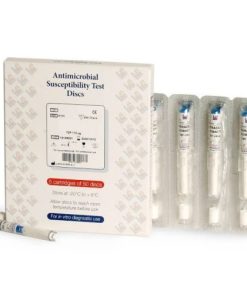Anti-TG Reagent – Jaj International
৳ 18,200৳ 22,000 (-17%)
In stock
Anti-TG Reagent – Jaj International
Brand: JAJ
Origin: USA
Packaging Size: Bottle
Number of Tests: 96
Categories: Lab Reagents, Elisa Test kit
Tags: Anti-TG Reagent, Jaj international Anti-TG Reagent, Jaj international Reagent
Frequently Bought Together
-
Add to Package (৳ 18,200
৳ 22,000(-17%)) -
Add to Package (৳ 5,880
৳ 6,700) -
Total Price: ৳ 24,080
- This item: Anti-TG Reagent - Jaj International(৳ 18,200
৳ 22,000(-17%)) - HCV (Anti- HCV) Reagent - Jaj International(৳ 5,880
৳ 6,700)
Anti-TG Reagent – Jaj International
The Quantitative Determination of Thyroglobulin (Tg) Autoantibodies in Human Serum or Plasma by a Microplate Enzyme Immunoassay, Colorimetric. Measurements of Tg autoantibodies may aid in the diagnosis of certain thyroid diseases such as Hashimoto’s and Grave’s as well as nontoxic goiter.
Antibodies to thyroglobulin have been shown to be characteristically present in patients with thyroiditis and primary thyrotoxicosis.1,2 This has led to clinical measurement becoming a valuable tool in the diagnosis of thyroid dysfunction. Passive Hemagglutination (PHA) methods have been employed in the past for measurements of antibodies to Tg.
PHA tests do not have the sensitivity of enzyme immunoassay and are limited by subjective interpretation. This procedure, with the enhanced sensitivity of EIA, permits the detectability of subclinical levels of antibodies to Tg.
In addition, the results are quantitated by a spectrophotometer, which eliminates subjective interpretation. DRG’s microplate enzyme immunoassay methodology provides the technician with optimum sensitivity while requiring a few technical manipulations. In this method, serum reference, diluted patient specimen, or control is first added to a microplate well. Biotinylated thyroglobulin (Tg) is added, and then the reactants are mixed.
Reaction results between the autoantibodies to Tg and the biotinylated Tg to form an immune complex, which is deposited to the surface of streptavidin-coated wells through the high-affinity reaction of biotin and streptavidin.
After the completion of the required incubation period, aspiration or decantation separates the reactants that are not attached to the wells. An enzyme anti-human IgG conjugate is then added to permit quantitation of reaction through interacting with human IgG of the immune complex.
After washing, the enzyme activity is determined by the reaction with the substrate to produce color. The employment of several serum references of known antibody activity permits the construction of a graph of enzyme and antibody activities. In comparison to the dose-response curve, an unknown specimen’s enzyme activity can be correlated with the autoimmune antibody level. The reagents required for the sequential ELISA assay include immobilized antigen, circulating autoantibody, and enzyme-linked species-specific antibodies.
In this procedure, the immobilization takes place during the assay at the surface of a microplate well through the interaction of streptavidin coated on the well and exogenously added biotinylated Thyroglobulin antigen. Upon mixing a biotinylated antigen and a serum containing the autoantibody, reaction results between the antigen and the antibody to form an immune complex.
+Simultaneously, the complex is deposited to the well through the high-affinity reaction of streptavidin and biotinylated antigen. After the incubation time, the well is washed to separate the unbound components by aspiration and/or decantation.
The enzyme-linked species-specific antibody (anti-h-IgG) is then added to the microwells. These conjugates bind to the immune complex that formed. The anti-h-IgG enzyme conjugate that binds to the immune complex in a second incubation is separated from unreacted material by a wash step. The enzyme activity in this fraction is directly proportional to the antibody concentration in the specimen.
By utilizing several different serum references of known antibody activity, a reference curve can be generated from which the antibody activity of an unknown can be ascertained.
Buy the Best Biochemistry Analyzer From Medistorte
Brand
Jaj
Be the first to review “Anti-TG Reagent – Jaj International” Cancel reply
You must be logged in to post a review.






Reviews
There are no reviews yet.